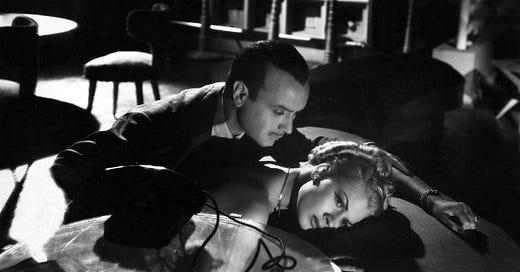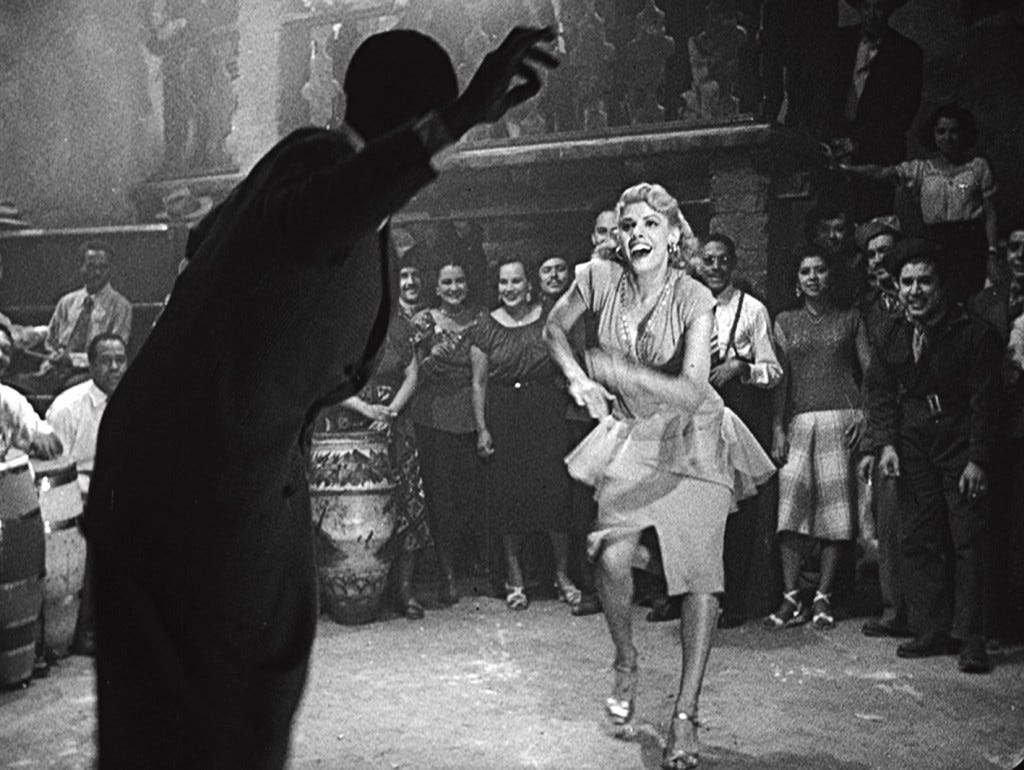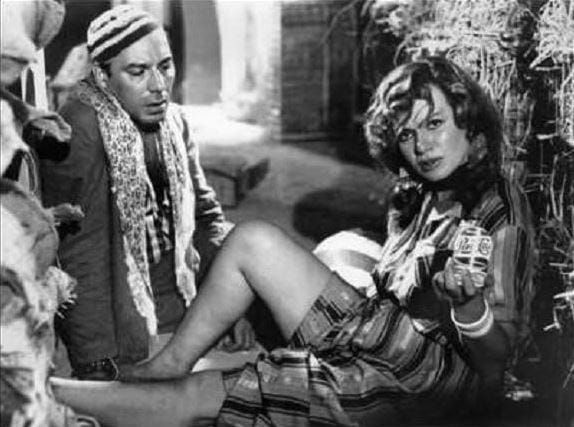C&C 32: Noir City Seattle Progress Report
A reminder of where I’ll be for the rest of this week, plus cocktails
When Noir City rolls into town, it moves at a blistering pace. Over the opening weekend, ten of the festival’s eighteen titles screened at SIFF’s Egyptian Theater. Time constraints forced me to be choosy. I limited myself to films that were new to me, with one singular exception. Given this year’s international theme of Darkness Has No Borders, I still made plenty of trips to the theater.
Rosemarie and I were there for the first half of opening night’s double bill, the unveiling of the Film Noir Foundation’s latest restoration. Never Open That Door (No Abras Nunca Esa Puerta, Argentina, 1952) is based on a pair of stories by Cornell Woolrich, the most adapted author in the noir canon. “Someone on the Phone” tells the tale of a well-off brother and sister, and what happens when the former seeks vengeance for the latter’s misfortune. In “The Hummingbird Comes Home,” an elderly blind woman who has long prayed for her vagabond son to return is disappointed when he finally does. Given that Woolrich is the master of the twist, I won’t say any more. Plus, you’ll get a chance to see the film soon enough. Host Eddie Muller shared the news that Never Open That Door, along with a third Woolrich adaptation that had been excised, expanded, and released as a separate feature (If I Should Die Before I Wake, aka Si muero antes de despertar, 1952), will air on TCM’s Noir Alley later this year. Favorite thing about the film: the row of twenty-somethings sitting behind us who gasped throughout at the suspense, particularly in the second half.
Ten years ago, I saw Victims of Sin (Victimas del pecado, Mexico, 1951) at Noir City in San Francisco and emerged a changed man. At the time, I said this film, a first-rate example of the rumberas or nightclub movie starring the radiant Ninón Sevilla, was like compressing an entire telenovela into ninety unhinged minutes. I wanted to see it again in a new 4K restoration and with a packed house, because nothing can prepare an audience for how wild this movie is. It’s packed with forthright scenes about sex that you’d never find in an American film from the same era, only for the action to stop cold for a red-hot dance number. Mambo maestro Pérez Prado is in the movie, for crying out loud. As expected, it played like gangbusters.
Cairo Station (Bāb Al-Hadïd, 1958) was the real draw, a rare chance to take in Egyptian noir. As Eddie explained, no actor of note dared to take on the lead role in Youssef Chahine’s groundbreaking film, so the director stepped in front of the camera himself to play a handicapped news vendor at the title terminus. The vendor’s growing obsession with a free-spirited woman who also works at the station provides the spine for a narrative that also includes a contentious unionization drive and a pair of clandestine lovers saying a secret goodbye, Chahine using a crime story to offer a portrait of mid-century Egyptian society. A fascinating and ultimately sad film.
I take over the emcee duties for Eddie starting on Monday, February 19, and I have some terrific films to introduce. If you’re in Seattle, swing on by. Here’s the Seattle Times on the festival, with quotes from Eddie and yours truly. The remaining schedule:
Monday, February 19 – Plunder Road (1957) / Symphony for a Massacre (France, 1963)
Tuesday, February 20 – Black Tuesday (1954) / Le Trou, aka The Hole (France, 1960)
Wednesday, February 21 – The Asphalt Jungle (1950) / Four Ways Out (Italy, 1951)
Thursday, February 22 – La Bête Humaine (France, 1938) / Human Desire (1954)
What I’m Reading
In the New York Times, Eric Asimov on how the shift “away from hospitality toward sales and volume” in restaurants emerging from the pandemic could spell the end for the sommelier.
Also in the Times, novelist Rachel Kadish on the most important writing exercise she has ever assigned.
Ted Gioia offers his State of the Culture 2024 address and, as we collectively enter “the Dopamine loop,” it isn’t looking good.
What I’m Drinking
Amanda Schuster’s Signature Cocktails (2023) is not only a gorgeous book, it’s also cannily organized. A chronological survey of mixed drinks that express “the nature of the time, person, venue, city, or country” in which they were created, it ranges from Atholl Brose, a Hogmanay tipple dating from the 15th century, to a new cocktail concocted specifically for this volume by Agostino Perrone of London’s Connaught Hotel.
The first beverage to catch my eye was the Fanciulli, created by Albert Stevens Crockett at New York’s Waldorf-Astoria hotel bar and christened after the conductor who succeeded John Philip Sousa as leader of the United States Marine Band. It contains a generous blast of Fernet-Branca, the bitter amaro that is an acquired taste and one not always in demand among those of us who have acquired it. I preferred the Larceny and Old Lace, a milder and more herbaceous variation courtesy of Frank Caiafa, who also toiled behind the stick at the Waldorf.
The Fanciulli
1 ½ oz. bourbon or rye
¾ oz. sweet vermouth
¾ oz. Fernet-Branca
Stir. Strain. Express the oils from an orange twist over the glass. Garnish with the orange twist and a cocktail cherry on a pick.
The Larceny and Old Lace
1 ½ oz. bourbon (Caiafa recommends Larceny)
¾ oz. sweet vermouth (Caiafa suggests Carpano Antica)
¾ oz. Cynar
1 dash orange bitters
Stir. Strain. Express the oils from a lemon twist over the glass. Garnish with the lemon twist and a cocktail cherry on a pick.







I love the Fanciulli!
When I used to go to the Zig Zag I think Murray made me one of these once, and when we talked about it I think my take on it was that the Fanciulli was like a Bonsoni with teeth.